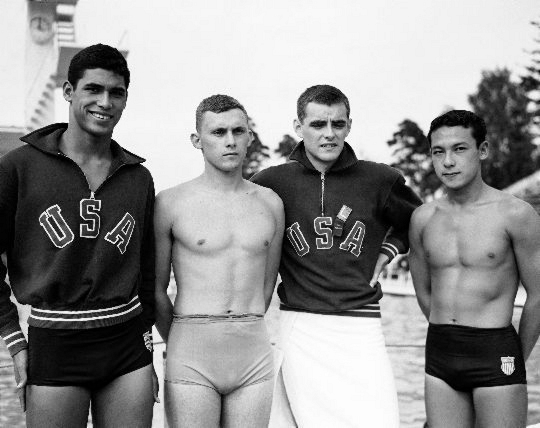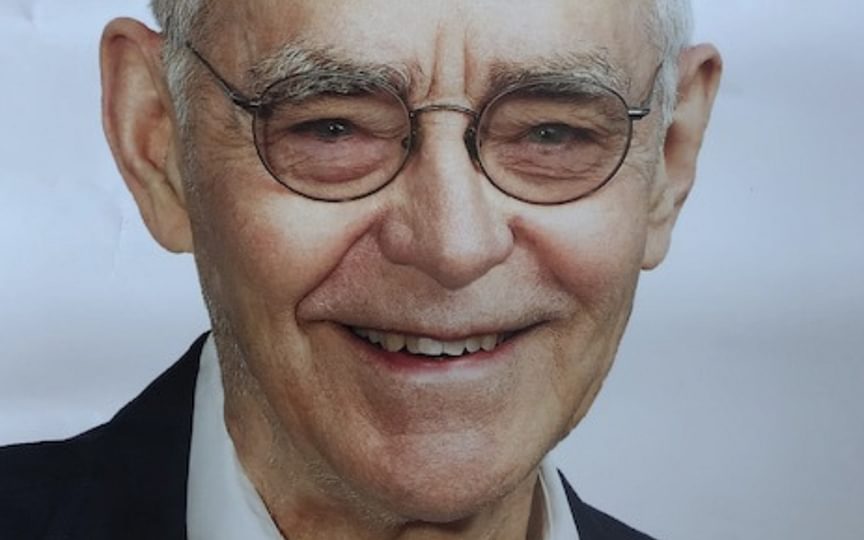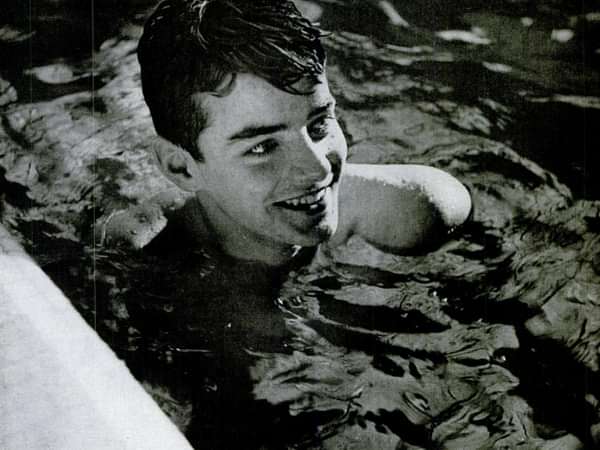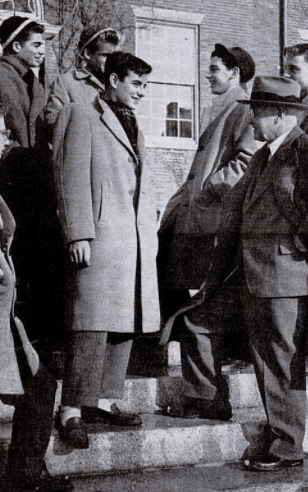(Ipswich, MA) – In the summer of 1945, Head of School Claude Fuess was presented with an odd request. An incoming 9th grader, James “Jim/Jimmy” McLane ’49, who was already a National Champion, was scheduled to swim in an international competition, but he had no team to represent. Might Mr. Fuess allow Jim to represent Andover? Although hesitant to establish a precedent, Mr. Fuess acquiesced and allowed Jim to matriculate early. Aware of his new allegiances, upon winning an event at the meet, Jim climbed onto the podium with an “A” taped to his sweatshirt.
So began Jim’s Andover career.
Life Before Andover
Born in Pittsburgh, PA, Jim settled in Akron, OH and began to swim. At the 1944 National AAU outdoor long-distance championships, 13-year-old Jim won the four-mile-swim. While sitting on the dock recuperating, a stranger came up behind him and placed his finger on Jim’s neck. When Jim asked what he was doing, the stranger responded, “I’m Robert Kiphuth, coach of the Yale swimming team, and I’m taking your recovery rate.” Thus launched a critical relationship in Jim’s life.
As Jim told Coach Kiphuth’s biographer, Peter Kennedy, in 2016, “I was going through a bad period… I was having difficulty with my coach [in] Akron… I was looking for another coach. I called Bob Kiphuth, and Kiphuth said ‘for Heaven’s sake come on down to New Haven…’ He basically became my father for the next ten years.” In addition to being among the handful of most influential people in the history of swimming, Coach Kiphuth knew Andover. His son had captained Andover’s 1936 team that went 7-1, and the coach introduced Jim to the school and helped secure the financial assistance Jim needed in order to attend.
Andover: the Early Years
Most 9th-graders at Andover do not have a reporter from Life magazine shadow them for 48-hours in order to write a profile. Jim did, and you can read the article, which starts on page 75. At his first Andover meet, Jim broke the school record in the 200-yard freestyle and continued to break it in each subsequent meet. With one exception. As the Phillipian notes, “It’s a shame that the gun didn’t go off to warn Jim McLane of his last 50 yards in the 200 freestyle event… last Saturday [against Deerfield], thus causing him to swim two extra pool lengths.”
In the summer of 1946, Jim, nicknamed “Fishy” during his first year at Andover, went to a meet in Havana. Swimming the 800-meter freestyle in front of a crowd of thousands that included, as Jim liked to note, Ernest Hemingway, he broke his first World record. You can watch the newsreel of it.
Back at Andover, on Saturday, 22 February 1947, Jim broke the National High School record in the 440-yard freestyle by seven seconds with a 4:49.3. Later that season, Jim established a new National High School record in the 200-yard free in 2:00.3. Before he graduated from Andover, Jim went on to break his national record in the 440 two more times, his 200 record three more times, and he added the 220-yard free, too.
Andover: 1948
1948 was Jim’s year, though. At Andover, he joined PG Bob Brawner ’48, who went on to hold the World record in breaststroke, 6’5” Richard “Shorty” Thoman ’49, who went on to hold the World record in backstroke as well as in several freestyle relays, and fourteen other swimmers and divers. Together they formed perhaps the best team in the history of high-school swimming. It certainly is the strongest team in Andover’s history. Thanks to the fierce advocacy of their captain, Jim Carroll, the 1948 Team was among the first class to be inducted into Andover’s Hall of Honor.
London: 1948
That summer, between his Upper and Senior years, Jim traveled to London to represent the United States in the Olympic Games. He won a Gold medal as a member of the 4x200-meter freestyle relay, which also set the World record, as well as a Silver in the 400-meter freestyle.
It was Jim’s Gold medal and Olympic record-setting performance in the 1500-meter freestyle, though, that solidified his reputation as “perhaps the greatest tactician in swimming.” As the citation for his 1970 induction into the International Swimming Hall of Fame (ISHoF) describes:
"High School boy McLane studied the great John Marshall and found the Australian liked to swim by hugging the lane line on his breathing side. McLane, who had a powerful kick, swam in the next lane and hugged the other side of the same lane line, sprinting out one body length ahead of Marshall. Kicking hard, McLane let his splash frustrate the Australian. McLane won, then swam with Marshall for three years at Yale."
Jim’s tactical skills were not limited to the pool. During a 2013 interview, Jim said, “I would never do the Olympic parades but hoped my competition did. Those parades would make you stand on your feet for three hours. It was exhausting.” As recently as May, the last time I spoke to him, Jim’s memories of tactics and techniques, of the traits of the other swimmers of his era, was remarkable. He so clearly loved swimming.
Back to Andover
It is hard to glean how the Andover community reacted to Jim’s Olympic performance between 11th and 12th
grade. An edition of the Phillipian
from October notes—on page 6:
"Biggest Andover sports news this summer came from London… By copping the grueling 1500-meter freestyle swimming event, Jim McLane became the first Andover undergraduate to ever win an Olympic title. He lost his chance for a double victory when he was upset in the 400-meter freestyle by Hawaiian Bill Smith."
Jim’s senior season was marked by records, illness, and more records. Out of the pool, he was a member of the varsity football team and a cheerleader. He even threw the shot-put and hammer. A resident of Bishop, he was a member of Student Congress, and in the “senior superlatives” of the 1949 Pot Pourii, Jim was cited under both “athlete” and “modest.”
1949-1955
In 1949, Jim, along with John Marshall and Wayne Moore, formed the “three M’s,” the heart of the greatest Yale swimming class in history. (The class of 1953 was so good Jim’s Andover teammate Dick Thoman wasn’t even considered among the top three). Jim captained this freshmen team during the 1950 season. Knowing the strength of his freshmen class, Coach Kiphuth entered both the Yale varsity team (Yale “A”) and the Yale freshmen team (Yale “B”) into the 1950 AAU Swimming Championships, essentially the senior national club championships. The Yale freshmen beat their elders and won the national championship, a unique accomplishment in the annals of swimming.
Jim’s first three seasons at Yale saw successes, but not ones quite comparable to his teenage years. In 1952, however, Jim was again named an Olympian—in fact, he captained the U.S. team—and traveled to Helsinki. There, Jim placed fourth in the 1500-meter freestyle and seventh in the 400. He was also a member of the 4x200-meter free relay, which successfully defended its Olympic title and set a new World standard.
Helsinki marked the second of two Olympiads in which Jim was the fastest 200-meter freestyler in the United States. Unfortunately, the 200 as an individual event was not part of the Olympic program in these years. Who knows how Jim would have performed?
Upon his return to Yale for his senior year, Jim built on this second Olympic experience and saw his return to the pinnacle of swimming, winning a collegiate national title. As the New York Times noted on 27 March 1953:
"This was McLane’s first national title since entering Yale four years ago. As a schoolboy prodigy…Jimmy won twelve national AAU distance crowns and the 1948 Olympic 1500-meter championship. But although he himself was swimming better than ever, he was overshadowed in varsity competition until this year by Marshall, Moore, and Konno."
Peter Kennedy’s biography, Kiphuth of Yale, highlights:
"Kiphuth labeled McLane as a competitor who thoroughly enjoyed the cunning and calculated pre-race mental preparation… Kiphuth loved to reminisce about each of his great distance stars and their moments of glory. Kiphuth enjoyed highlighting the ‘mental toughness’ that led to the fantastic comeback of McLane in his farewell to collegiate swimming."
An English major at Yale, Jim was also a member of Skull and Bones, the Aurelian Society, the Elizabethan Club, and the Pundits. Upon graduation, Jim joined the U.S. Army Counterintelligence Corps during the Korean Conflict, and he continued to swim. In 1955, at the age of 24, Jim won three Gold medals at the Pan Am Games. As Jim’s 1970 ISHoF citation states: “Tired of swimming but preferring it to guard duty and K. P., the old pro swam just long enough and hard enough to win again.”
Jim retired a 21-time AAU National Champion, but as the ISHoF clarifies, his “greatest contribution to swimming was as a high school boy wonder. He was the forerunner of a youth movement that has put U.S. swimming back on top.”
After Swimming
In 1956, Jim took a position at Time Life
in its advertising and marketing division. Ten years later, he moved to General Mills as its Venture Team Manager and formed the Direct Marketing Division.
Jim was diagnosed with multiple sclerosis in 1975 and retired. As his second wife, Carol, said in an interview with the Ipswich Local News after Jim’s death: “That put a crimp in his career quite a bit.” It is fair to surmise that the second 45 years of Jim's life were even more impressive than the first 45.
In retirement, Jim volunteered for various healthcare causes, including Massachusetts General Hospital. He also pursued his interests in reading, drama, movies, music, writing, and travel. He lived in the south of France for a number of years and was a devoted Secretary for the Class of 1949, writing crisp, erudite notes for the Andover Bulletin
from Europe and later from his home for the last thirteen years, Ipswich.
Well into his 80s, Jim was an active swimmer at the Ipswich YMCA—he could still cut through the water, leading his lane mates to slip into another lane operating at a slower pace. In recent years, Jim’s health declined, and he had to give up swimming.
“He always found a reason to look at the better aspects of life,” Carol told the Ipswich newspaper. “He just stepped up to the plate. He really did. He was not one to feel sorry for himself.”
In addition to Carol, Jim is survived by his four children—for whom he was “an adored hero”—a brother and a sister, seven grandchildren, and two great-grandchildren.
In 2013, back when he was still able to swim at the Y, Jim gave his own interview to the Ipswich Local News. When asked to give his advice to aspiring Olympians, Jim said they should enjoy swimming and focus on the work.
“Medals are important to the average person. They are not very important to me. When I remember my achievements, I remember the work and training not the medal--that’s what is most valuable.”
finis origine pendet









